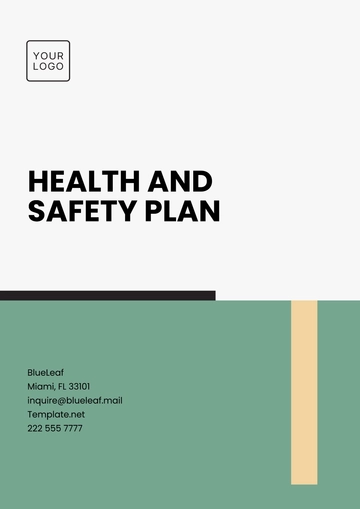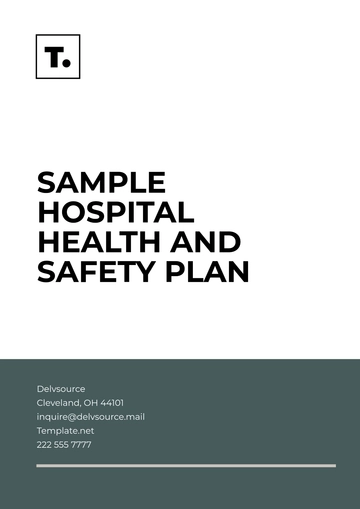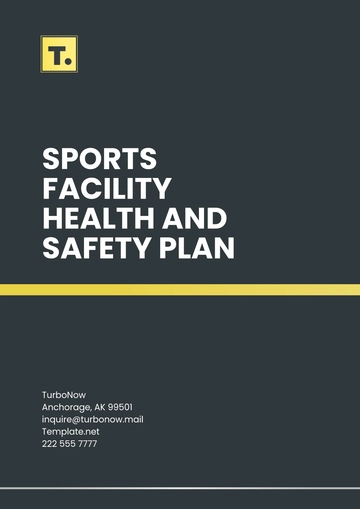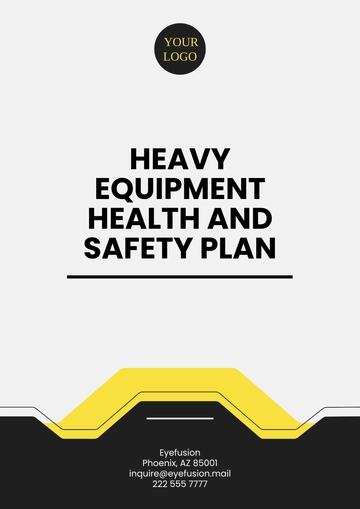Free Mental Health Safety Plan

I. Introduction
A. Purpose
The purpose of this Mental Health Safety Plan is to provide strategies and steps to cope with mental health crises and prevent self-harm. It aims to empower individuals to manage their mental health challenges effectively.
B. Scope
This plan applies to individuals experiencing mental health issues, therapists, counselors, and caregivers involved in the mental health support system.
II. Mental Health Safety Team
A. Team Members
The Mental Health Safety Team comprises:
Primary Therapist: [Your Name]
Secondary Contact: [Secondary Contact Name]
Emergency Contact: [Emergency Contact Name]
Support Person: [Support Person Name]
III. Patient Information
A. Personal Details
Patient Name: [Patient Name]
Date of Birth: [Date of Birth]
Contact Information: [Patient Contact Details]
B. Diagnosis
[Patient Diagnosis and Relevant Mental Health Conditions]
IV. Coping Strategies
A. Coping Skills
Coping skills are essential for managing stress and maintaining mental well-being. Here are some effective coping techniques:
1. Distraction Techniques:
Engage in hobbies such as painting, crafting, or playing musical instruments.
Listen to music or podcasts to shift focus away from distressing thoughts.
Practice mindfulness by focusing on the present moment and observing sensations around you.
2. Grounding Exercises:
Practice deep breathing exercises to center yourself and calm the mind.
Use the 5-4-3-2-1 grounding technique:
Identify and name five things you can see.
Acknowledge four things you can touch.
Notice three things you can hear.
Identify two things you can smell.
Acknowledge one thing you can taste.
Focus on your senses by describing in detail the texture, color, and temperature of objects around you.
3. Relaxation Techniques:
Progressive muscle relaxation: Tense and then relax each muscle group in your body, starting from your toes and working your way up to your head.
Guided imagery: Visualize a peaceful and calming scene, such as a serene beach or a tranquil forest, and immerse yourself in the sensory details.
Take a warm bath or shower to relax your muscles and soothe your mind.
V. Crisis Intervention Plan
A. Warning Signs
Identify early warning signs and symptoms of mental health crises, including:
Sudden Changes in Behavior: Abrupt changes such as withdrawal from social activities, increased irritability, or agitation.
Extreme Mood Swings: Rapid shifts from extreme highs to lows, or prolonged periods of sadness or hopelessness.
Sleep or Appetite Changes: Significant alterations in sleep patterns or appetite leading to weight loss or gain.
B. Action Steps
When early warning signs are identified, it's essential to take proactive steps:
Reach Out for Support:
Encourage contacting a trusted friend, family member, or mental health professional.
Implement Coping Strategies:
Practice coping skills like deep breathing or engaging in relaxing activities.
Seek Professional Help if Necessary:
If the situation escalates, seek immediate assistance from a mental health professional or crisis hotline.
C. Emergency Contacts
Contact Type | Name | Phone |
|---|---|---|
Primary Therapist | [Your Name] | [Your Company Number] |
Secondary Contact | [Secondary Contact Name] | [Secondary Contact Phone] |
Emergency Services | [Emergency Services] | [Emergency Services Number] |
VI. Medication Management
A. Medication Information
Prescribed Medications: [List of Medications]
Dosage Instructions: [Dosage Details]
Emergency Medications: [Emergency Medications Information]
VII. Wellness Activities
A. Daily Routine
Morning Routine | Evening Routine |
|---|---|
Wake up at a consistent time. | Wind down electronics an hour before bedtime. |
Practice mindfulness or meditation for 10 minutes. | Practice relaxation techniques like deep breathing. |
Prepare and eat a healthy breakfast. | Reflect on the day and jot down thoughts in a journal. |
Engage in light stretching exercises. | Engage in a calming activity such as reading a book. |
Plan tasks and priorities for the day ahead. | Settle into bed at a regular bedtime for adequate sleep. |
VIII. Follow-Up Plan
A. Regular Check-Ins
Schedule regular follow-up appointments with the therapist to monitor progress and adjust the safety plan as needed.
B. Crisis Debriefing
After any crisis or intervention, conduct a debriefing session to assess what worked well and identify areas for improvement.
IX. Review and Updates
A. Plan Review
The Mental Health Safety Plan will be reviewed regularly, at least [Frequency of Review], to ensure its effectiveness and relevance.
B. Updates
Any changes in the patient's condition or treatment plan will prompt an immediate update to the safety plan.
X. Encouragement and Support
A. Support Resources
Provide information on additional support resources, hotlines, or online forums for ongoing support and encouragement.
- 100% Customizable, free editor
- Access 1 Million+ Templates, photo’s & graphics
- Download or share as a template
- Click and replace photos, graphics, text, backgrounds
- Resize, crop, AI write & more
- Access advanced editor
Support mental health with an editable Mental Health Safety Plan Template from Template.net. This customizable template, editable in our AI Tool, helps outline steps to manage mental health crises effectively.
You may also like
- Finance Plan
- Construction Plan
- Sales Plan
- Development Plan
- Career Plan
- Budget Plan
- HR Plan
- Education Plan
- Transition Plan
- Work Plan
- Training Plan
- Communication Plan
- Operation Plan
- Health And Safety Plan
- Strategy Plan
- Professional Development Plan
- Advertising Plan
- Risk Management Plan
- Restaurant Plan
- School Plan
- Nursing Home Patient Care Plan
- Nursing Care Plan
- Plan Event
- Startup Plan
- Social Media Plan
- Staffing Plan
- Annual Plan
- Content Plan
- Payment Plan
- Implementation Plan
- Hotel Plan
- Workout Plan
- Accounting Plan
- Campaign Plan
- Essay Plan
- 30 60 90 Day Plan
- Research Plan
- Recruitment Plan
- 90 Day Plan
- Quarterly Plan
- Emergency Plan
- 5 Year Plan
- Gym Plan
- Personal Plan
- IT and Software Plan
- Treatment Plan
- Real Estate Plan
- Law Firm Plan
- Healthcare Plan
- Improvement Plan
- Media Plan
- 5 Year Business Plan
- Learning Plan
- Marketing Campaign Plan
- Travel Agency Plan
- Cleaning Services Plan
- Interior Design Plan
- Performance Plan
- PR Plan
- Birth Plan
- Life Plan
- SEO Plan
- Disaster Recovery Plan
- Continuity Plan
- Launch Plan
- Legal Plan
- Behavior Plan
- Performance Improvement Plan
- Salon Plan
- Security Plan
- Security Management Plan
- Employee Development Plan
- Quality Plan
- Service Improvement Plan
- Growth Plan
- Incident Response Plan
- Basketball Plan
- Emergency Action Plan
- Product Launch Plan
- Spa Plan
- Employee Training Plan
- Data Analysis Plan
- Employee Action Plan
- Territory Plan
- Audit Plan
- Classroom Plan
- Activity Plan
- Parenting Plan
- Care Plan
- Project Execution Plan
- Exercise Plan
- Internship Plan
- Software Development Plan
- Continuous Improvement Plan
- Leave Plan
- 90 Day Sales Plan
- Advertising Agency Plan
- Employee Transition Plan
- Smart Action Plan
- Workplace Safety Plan
- Behavior Change Plan
- Contingency Plan
- Continuity of Operations Plan
- Health Plan
- Quality Control Plan
- Self Plan
- Sports Development Plan
- Change Management Plan
- Ecommerce Plan
- Personal Financial Plan
- Process Improvement Plan
- 30-60-90 Day Sales Plan
- Crisis Management Plan
- Engagement Plan
- Execution Plan
- Pandemic Plan
- Quality Assurance Plan
- Service Continuity Plan
- Agile Project Plan
- Fundraising Plan
- Job Transition Plan
- Asset Maintenance Plan
- Maintenance Plan
- Software Test Plan
- Staff Training and Development Plan
- 3 Year Plan
- Brand Activation Plan
- Release Plan
- Resource Plan
- Risk Mitigation Plan
- Teacher Plan
- 30 60 90 Day Plan for New Manager
- Food Safety Plan
- Food Truck Plan
- Hiring Plan
- Quality Management Plan
- Wellness Plan
- Behavior Intervention Plan
- Bonus Plan
- Investment Plan
- Maternity Leave Plan
- Pandemic Response Plan
- Succession Planning
- Coaching Plan
- Configuration Management Plan
- Remote Work Plan
- Self Care Plan
- Teaching Plan
- 100-Day Plan
- HACCP Plan
- Student Plan
- Sustainability Plan
- 30 60 90 Day Plan for Interview
- Access Plan
- Site Specific Safety Plan





























